Steel tubular heating radiators for residential and
One of the most important parameters in any room is a comfortable temperature. It can be achieved with the help of various heating systems that are used in residential and industrial construction.
Most often, heat is transferred to the atmosphere of a room with the help of radiators, the design of which can be any. Today we will talk about the tubular structure, tell you about its characteristics, dimensions and other parameters.
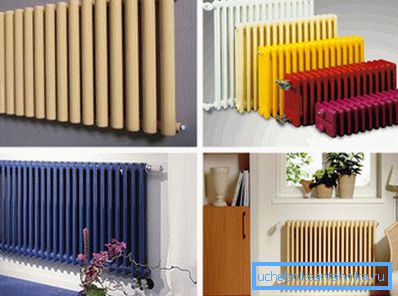
The principle of operation of radiators
Although there are several ways to heat a room, the oldest and most reliable are still considered to be using radiators consisting of sections. Inside the latter, channels are made necessary for the movement of the coolant, which is most often ordinary water.
Consider the principle of operation of radiators in more detail, focusing on three components:
- Radiation - during operation, the batteries emit heat. By the way, it was noticed that dark items give into the atmosphere of a room more than light ones.
- Convection - type of heat transfer when the transfer of internal energy occurs in streams and jets.
- Thermal conductivity - the process of transferring thermal energy from heated bodies to less heated.

Make radiators from:
- cast iron;
- aluminum;
- become;
- copper.
They can also be bimetallic, for example, inside copper, and on top aluminum, or steel plus aluminum.
The design can be panel and tubular. The latter have become today especially in demand because of their efficiency and interesting design solutions. Below we consider these parameters in more detail.
Properties
Tubular radiators consist of several sections, like the vast majority of other structures of this type. However, they are not twisted in them, like in cast-iron, aluminum or bimetallic radiators of heating, but are welded together.
The degree of efficiency of the device depends on the number of tubes in the section. For example, the minimum efficiency can be obtained from 2 tubes, the best option is 6.
Tip: to heat a large area we recommend installing radiators of greater depth, in which the efficiency will be higher.
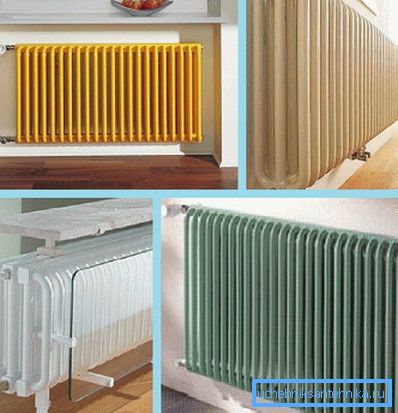
Usually tubular structures for heating are made of steel. The popularity of the material adds to its strength and reliability in operation, in addition, it endures aggressive environments. In our conditions, this parameter is considered important because the quality of the coolant is usually located at a low level.
These and other properties, such as low weight, which makes it possible to quickly assemble and disassemble equipment by hand, allow devices to remain in demand on the market. In addition, the price of a steel radiator is 2-5 times lower than a cast-iron or aluminum one of the same heating area.
Benefits:
- Hygiene, as the device has no sharp corners, it is easily cleaned from dust. The same parameter makes it safer for children.
- It tolerates the steel radiator heating pressure drops.
- Material of manufacture differs in resistance to corrosion. To improve its technical characteristics, it is coated inside with polymer compounds, which increase the service life of the devices.
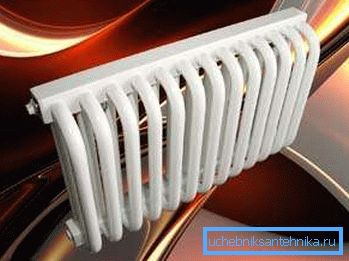
Disadvantages:
- Low heat emission, therefore, if we take the cost per 1 kW of power as the calculation point, the device will be the most expensive.
- Spot welding areas are a potential hazard of these radiators. Due to severe pressure drops, they can leak.
Tip: the installation of such devices is preferred in systems of autonomous heating.
Overall dimensions and pressure
The first parameter is necessary for the selection of the installation location of the heater:
| The size |
|
| Operating pressure | The devices are manufactured with the calculated ability to withstand the pressure of the coolant at 10-15 atm, which usually happens in high-rise buildings. In fact, this parameter is given with a margin, as the radiators are able to withstand more. The wall thickness of the pipes - 1-1,5 mm. |
Calculate the number of sections
As mentioned above, the tubular heater can be installed in the central heating system and in individual heating. Although the latter option is most preferable due to the low pressure of the coolant.
However, wherever it is installed, it is extremely important to make the correct calculation of the necessary number of its sections. Otherwise, you will not get the expected effect of comfort.
The design, although it has a sectional device, but it is not collapsible, so you cannot subsequently add the missing ones or remove the extra ones. The standard number is 2nd, 6th, 8th, and 12 sectional radiators, sometimes you can find commercially available batteries consisting of 14 or 16 batteries.
Tip: when calculating the number of sections, take into account that the average heat output of each can be in the range of 80-120 watts.
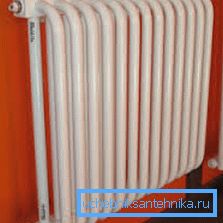
Construction instruction says that according to the standards for heating 1 m2 need to spend 100 watts of heat. You only need to know the area of the room and multiply this value by 100 watts.
The following factors should also be taken into account in the calculation:
- When there are 2 exterior walls and 1 window in the room, it is necessary to add 20% to the resulting figure.
- With 2 external walls and the 1st window, the demand increases by 30%.
- If the window faces north or northeast, the amount of heat should be added within 10%.
- When installing a tubular radiator, it has to be sunk in an uncovered deep niche, the heat transfer must be increased by 5%.
- For a closed niche with a solid panel and with 2 horizontal slots, increase the heat supply by 15%.
Tip: If there are several factors in the room that require an increase in heat energy, they need to be summed up in order to get a final need for heating.
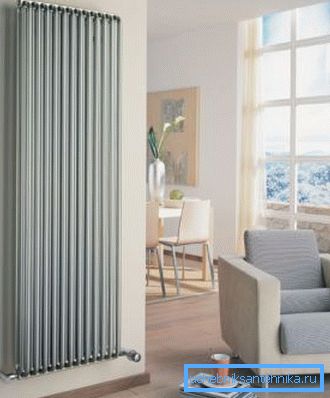
Example
If the area of the room is 20 m2 you need - 20 x 100 W = 2000W. After that, it is necessary to divide by the average heat transfer value of one section - 2000: 100W = 20 (sections). Now you can purchase either one or two radiators so that the sum of their sections is equal to 20.
If the room has 1 window and 2 external walls, add 4 more sections - 20 x 20% = 24 sections.
How to connect tubular radiators
There are three main ways to connect this type of heater to a home heating system:
- Bottom - the pipe from the heat source is supplied to the lower radiator pipe on the one hand, the outlet is connected to the other.
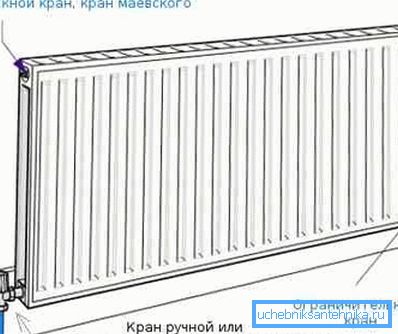
- Lateral - hot water pipe is connected to the upper pipe on one side, the removal is made from the lower end.
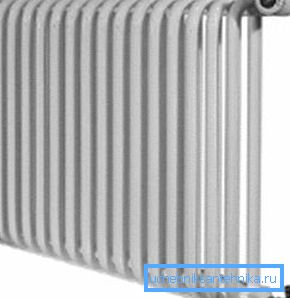
- Diagonal - the pipe from the heat source is fed to the upper branch pipe of the battery, while at the same time the outlet is made from the opposite side from the lower branch pipe.
Tip: Experts believe that the greatest effect of heat transfer from the radiator can be obtained with a side connection.
Tubular radiators in room design
Choosing a heater, we recommend to proceed not only from its cost, an important factor will be the appearance of the device. It is also advisable to take into account the architectural features of the buildings and the design of the room heating system.
At the same time, there are a lot of restrictions that may affect the selection of the heating device, for example, the design of the room and the properties of the material from which the radiator is made.
Although the range of such products is quite large, a special place is occupied by the concern Arbonia, the motto of which is “the heat of the premises in the best shape”. Its main products are tubular radiators made of steel, design radiators and towel warmers.

When designing a heating device, not only the optimal thermal distribution of radiation and convection, but also the aesthetic component of the device is taken into account. You can use the products in industrial and residential buildings, because of the rounded corners they do not pose a danger to people, and the easy cleaning allows even allergies to feel comfortable.
Conclusion
Having considered in detail in the article steel tubular-type heating radiators, one can say that they successfully fit into the space of any premises - residential and industrial. When choosing them, one should pay attention to the correct selection of sections, as well as to the aesthetic side of the devices.
It is best to apply them in the autonomous heating, where the pressure of the coolant is low. The video in the article will help you find additional information on this topic.